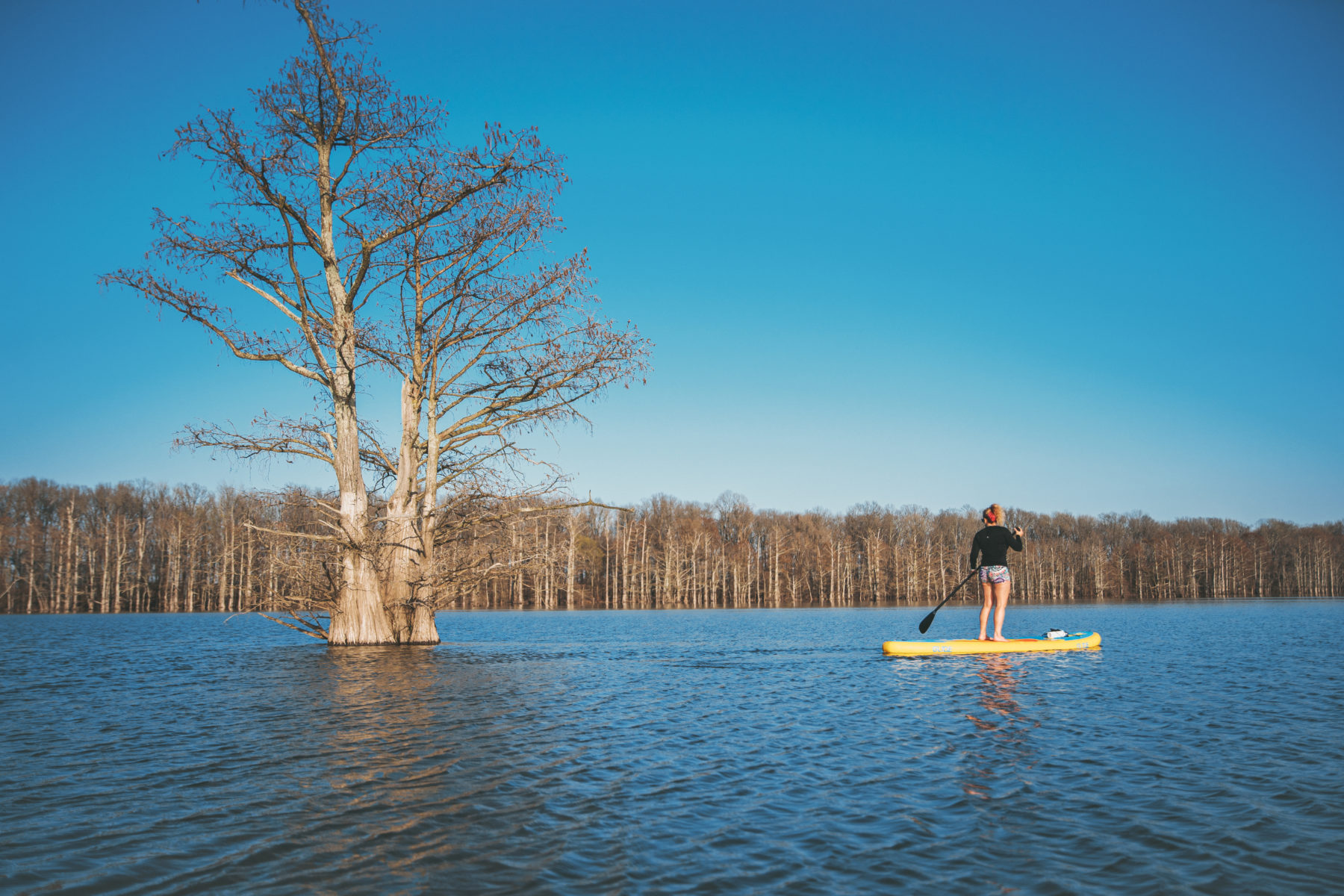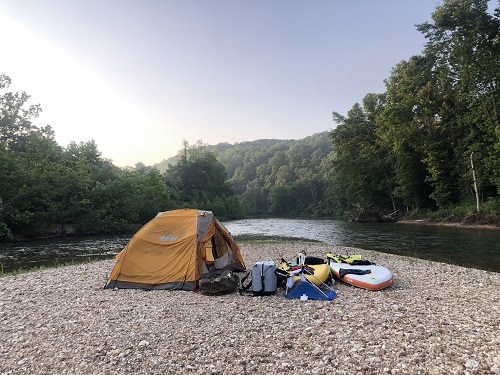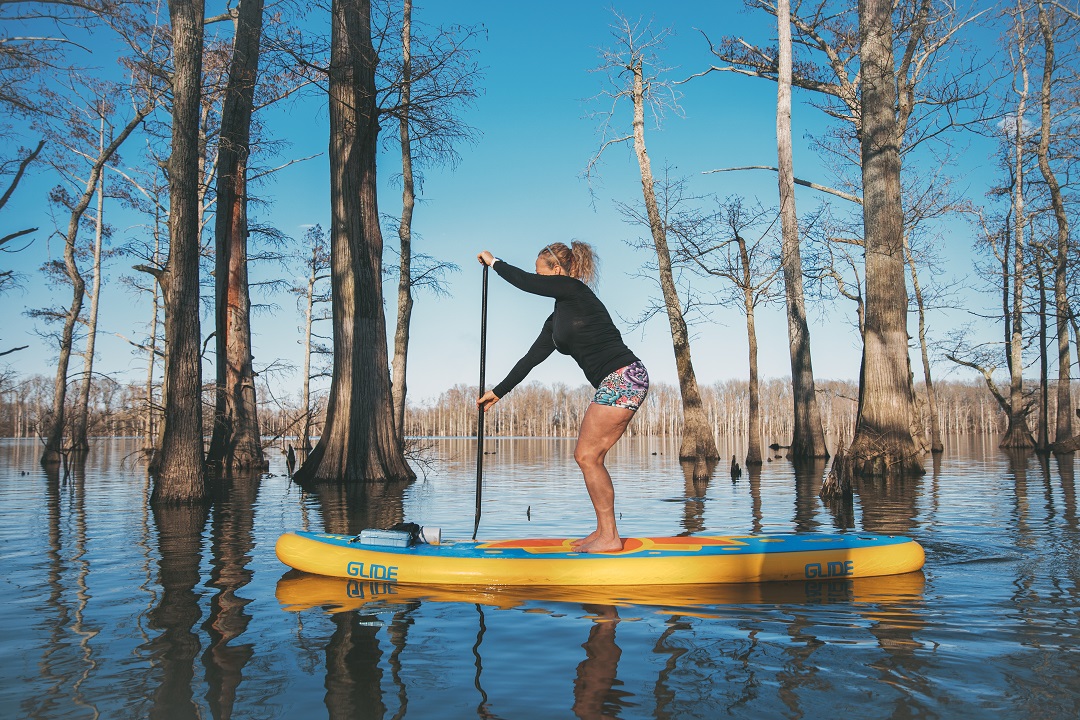In the past few years, stand-up paddleboarding (SUPing) has become one of the fastest growing water sports in America. While many other waterborne activities are limited to the summer season, particularly in the Midwest, SUPing can be an enjoyable year-round activity — as long as you plan ahead and bring the right gear.
Considerations for Cold
Fall weather brings a greater swing in temperatures, as it tends to be cooler in mornings and evenings but can feel summer-like in the middle of the day. Paddlers should be prepared for both high and low temperatures and for the possibility of getting wet in either.
Another consideration for fall and winter paddling is water levels. River levels are often low at this time of year, and some are not floatable or even accessible. Prior to setting out on your seasonal paddling adventure, do some research on the National Oceanic and Atmospheric Administration website (water.weather.gov) to have a safe, enjoyable experience.
Trip Planning
Casey House, an experienced kayaker and paddleboarder from Cape Girardeau, Missouri, has taken multiple trips on all different kinds of crafts, from a lazy afternoon flatwater paddle at Trail of Tears State Park to a weeklong SUP trip on the San Juan River.

Paddlers should be prepared for both high and low temperatures and for the possibility of getting wet in either. (Justin White)
Her primary advice for a SUP adventure is to plan ahead. “Know where you’re putting in and taking out, what you’re driving, what your vessels are…. Prepare a detailed itinerary, so someone knows what time to expect you to get off the river.”
Some outfitters reduce their hours and availability in the off-season, so call ahead to make sure you can schedule a shuttle, if needed. Check the weather and pack accordingly. Finally, before you leave, make sure all your gear is in working order.
House recommends always paddling with someone, and she says it’s vital that you honestly assess your own capabilities — your level of skill on the water and your skill in the wilderness. Plan a trip that aligns with your ability and experience.
Essential Gear
The right gear is essential for a seasonal SUP adventure. House emphasizes the importance of dressing in layers, choosing synthetics over cotton, to accommodate the changing temperatures as the day progresses. Shorts might be comfortable during the day, but you may need to add water- or splash-resistant pants as the weather cools.
Because there’s always the potential to get wet while paddling, “You need enough awareness to know how to get dry and get warm,” she said.
If you’re paddling in late fall or winter, add layers of merino wool and fleece. Invest in neoprene booties and neoprene gloves or pogies for paddling.
Pack a dry bag with an extra set of clothes, first-aid kit, silver emergency blanket, emergency fire starter, repair kit for your board, and a pump if your board is inflatable. And you need to know how to use each of these items.
For overnight or multi-day trips, House said, “Think like you’re backpacking. Bring a small camp stove, food that is appropriate — calorically dense — and plenty of water.”
Use cam-straps and carabiners to tie everything down securely. Even though many SUPs include an ankle strap, House advises against attaching yourself (or a pet) to the board when paddling on moving water, as the danger of getting trapped outweighs your board floating downstream.
Invest in a quality lifejacket that you can wear comfortably. An added benefit is that it can help keep you warm on cooler days.
Also be sure to bring a waterproof box or drybag to keep your phone handy, so you can photograph the glorious scenery when you take a break from paddling. Then, put the camera down, relax, and soak in the magic of the season.
There’s no rule that says you have to stand up the entire time, and these picturesque moments are what make a fall or winter SUP outing unforgettable.
Places to Paddleboard
Overnight or Multi-Day River Floats
Eleven Point and Current Rivers: Both are spring-fed, so they run all year, and there are gravel bars and places to camp along the bank. These rivers also have multiple outfitters that provide shuttles (be sure to call ahead to check availability prior to your trip).

Eleven Point and Current rivers have gravel bars on which to camp.
Meramec and Jack’s Fork Rivers: These waterways provide multiple access points for both shorter and longer floats.
One-Day River Floats
Courtois and Huzzah Rivers: Both are great for day floats. Check with outfitters such as Bass’ River Resort and Huzzah Valley Resort for river conditions and shuttle rates.
Bourbeuse River: Watch the water levels, as this river can rise or fall quickly. Be prepared for a long day of paddling; there are few access points, and most of the shoreline is privately owned.
Lake Paddles
By paddling on a lake, you have the advantage of putting in and taking out at the same place, so you don’t have to do quite as much planning. Another advantage is that you get to decide how far you go; however, remember that you’re only halfway when you decide to turn around. Reserve some energy for the paddle back.
Be mindful of the wind when you are on a lake. You might not notice a tailwind while paddling out, but the headwind coming back makes paddling significantly more challenging. Also, when paddling on a large, busy lake, pay close attention to boat traffic and avoid paddling during high-traffic times, especially if you’re a beginner.
Speaking of which, Post-Dispatch Lake in Forest Park offers paddleboard rentals and is small, making it great for first-timers. Lake of the Ozarks also has multiple places that rent paddleboards, with some that provide lessons.
Here’s a list of area lakes that are great for paddleboarding: Creve Coeur Lake (Maryland Heights, Mo.), Lake Girardeau (Cape Girardeau, Mo.), Simpson Lake (Valley Park, Mo.), St. Joe State Park (Park Hills, Mo.), Wakonda State Park (Lewis County, Mo.), Carlyle Lake (Carlyle, Ill.), Cedar Lake (Jackson County, Ill.), Horseshoe Lake (Madison County, Ill.), and Lake Lou Yaeger (Litchfield, Ill.).
Author: Missy Phegley is a egular contributor to Terrain Magazine.
Top Image: The author on a fall paddle. (Justin White)


Leave A Comment